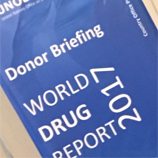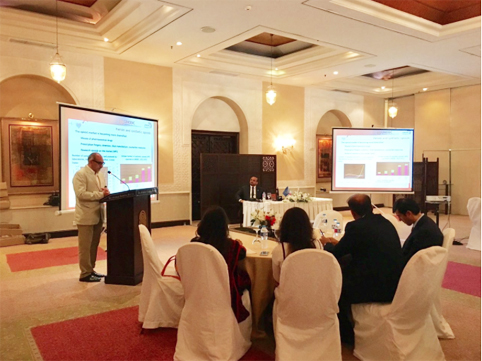The 2017 World Drug Report illustrates that 29.5 million people globally suffer from drug use disorders, with opioids the most harmfulBriefing to Donors on World Drug Report 2017
This year marks 20 years of the United Nations Office on Drugs and Crime (UNODC) presenting through the World Drug Repot in presenting global research into complex areas of drug use and supply, supporting international cooperation and informing policy choices with the latest estimates, information on trends and analysis. Pakistan Representative Mr Guedes gave a brief history on World Drug Report, and informed the audience, "The World Drug Report is published annually by the
United Nations Office on Drugs and Crime (UNODC). The first report was published in 1997, the same year the agency was established.
The World Drug Report 2017 is available in five separate booklets: the executive summary, together with the report's conclusions and policy implications; a global overview of drug use and supply; a market analysis of plant-based drugs; a market analysis of synthetic drugs; and a thematic booklet on the links between drugs and organized crime, illicit financial flows, corruption and terrorism. The report design is reader-friendly, maintaining the rigorous standards expected from the Office's flagship publication. The World Drug Report 2017 and the detailed statistical annex can be accessed at www.unodc.org/wdr2017 In his presentation, Dr. Niaz summarized the main findings of the WDR 2017. In 2015 about a quarter of a billion people used drugs. Of these, around 29.5 million people - or 0.6 per cent of the global adult population - were engaged in problematic use and suffered from drug use disorders. Opioids were the most harmful drug type and accounted for 70 per cent of the negative health impact associated with drug use disorders worldwide. Disorders related to the use of amphetamines also account for a considerable share of the global burden of disease. And while the market for new psychoactive substances (NPS) is still relatively small, users are unaware of the content and dosage of psychoactive substances in some NPS. This potentially exposes users to additional serious health risks. He also pointed out that hepatitis C is causing the greatest harm among the estimated 12 million people who inject drugs worldwide. Out of this number, one in eight (1.6 million) is living with HIV and more than half (6.1 million) are living with hepatitis C, while around 1.3 million are suffering from both hepatitis C and HIV. Overall, three times more people who use drugs die from hepatitis C (222,000) than from HIV (60,000). However, as stressed in the Report, despite recent advances in the treatment of hepatitis C, access remains poor, as treatment remains very expensive in most countries. Changing business models for drug trafficking and organized crime In 2014, transnational organized crime groups across the globe were estimated to have generated between one fifth and one third of their revenues from drug sales. Mobile communications offers new opportunities to traffickers, while the darknet allows users to anonymously buy drugs with a crypto-currency, such as bitcoin. While drug trafficking over the darknet remains small, there has been an increase in drug transactions, of some 50 per cent annually between September 2013 and January 2016 according to one study. Typical buyers are recreational users of cannabis, "ecstasy", cocaine, hallucinogens and NPS. Global Drug Market Trends The presentation showed that the spectrum of substances available on the drug market has widened considerably, The opioid market in particular is becoming more diversified, with a combination of internationally controlled substances like heroin, and prescription medicines that are either diverted from the legal market or produced as counterfeit medicines. NPS continued to evolve such that by 2015, the number of reported substances had nearly doubled to 483 compared with 260 NPS in 2012. Opium production is up and the cocaine market is thriving. In 2016, global opium production increased by one third compared with the previous year and this was primarily due to higher opium poppy yields in Afghanistan. The presentation also pointed to the expansion of the cocaine market, such that from 2013-2015, coca bush cultivation increased by 30 per cent mainly as a result of increased cultivation in Colombia. Following a period of decline, there are signs that cocaine use is increasing in the two largest markets, North America and Europe. Also there have are signs of an increasing market of cocaine in Asia as reflected in an increase in seizures of cocaine in the region. Drugs and terrorism Although not all terrorist groups depend on drug profits, some do. Without the proceeds of drug production and trafficking, which make up almost half of the Taliban's annual income, the reach and impact of the Taliban would probably not be what it is today. Up to 85 per cent of opium cultivation in Afghanistan occurs in territory under some influence of the Taliban. The presentation was followed by a very interactive question and answer session. The 2017 Report comes at a time when the international community has acted decisively to achieve consensus on a way forward for joint action. The outcome document unanimously adopted at 2016 special session of the UN General Assembly on the world drug problem contains more than 100 concrete recommendations for implementing balanced, comprehensive and integrated approaches to effectively addressing and countering the world drug problem |
|
|
|
 Islamabad 11 August 2017 - Mr. Cesar Guedes, the UNODC Country Office Representative in Pakistan and Dr. Kamran Niaz who is the senior Epidemiologist with the Research Branch, UNODC HQ, Vienna, gave a presentation on the World Drug Report 2017.
Islamabad 11 August 2017 - Mr. Cesar Guedes, the UNODC Country Office Representative in Pakistan and Dr. Kamran Niaz who is the senior Epidemiologist with the Research Branch, UNODC HQ, Vienna, gave a presentation on the World Drug Report 2017. 